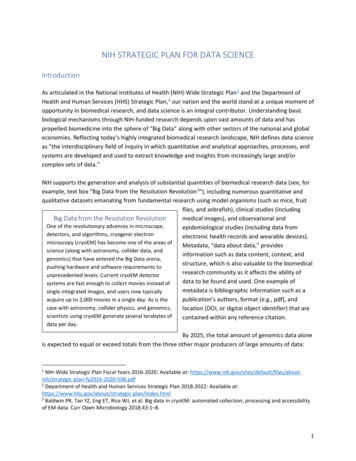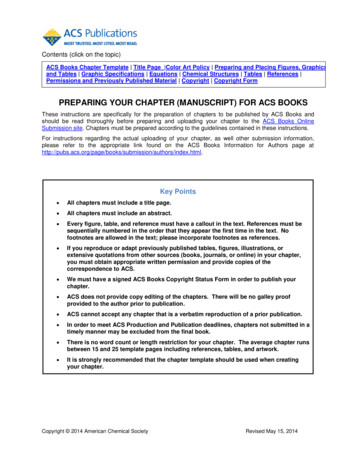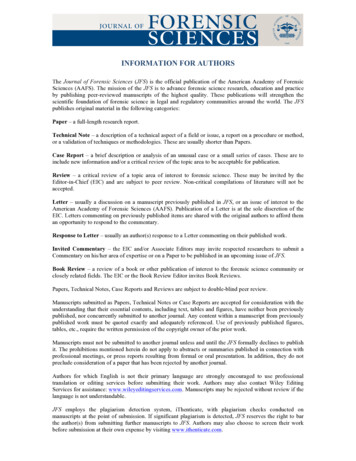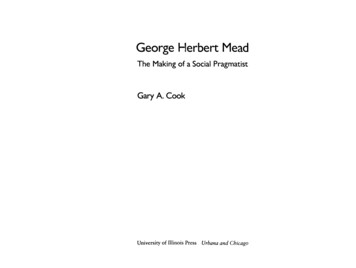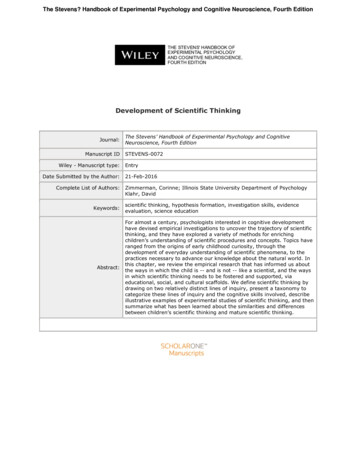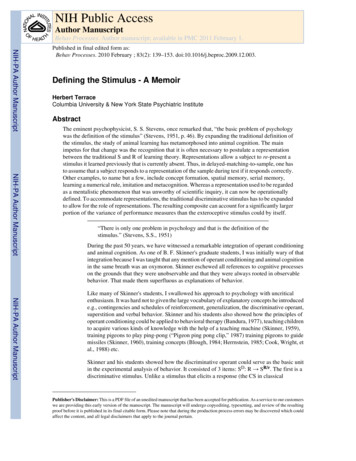
Transcription
NIH Public AccessAuthor ManuscriptBehav Processes. Author manuscript; available in PMC 2011 February 1.NIH-PA Author ManuscriptPublished in final edited form as:Behav Processes. 2010 February ; 83(2): 139–153. doi:10.1016/j.beproc.2009.12.003.Defining the Stimulus - A MemoirHerbert TerraceColumbia University & New York State Psychiatric InstituteAbstractNIH-PA Author ManuscriptThe eminent psychophysicist, S. S. Stevens, once remarked that, “the basic problem of psychologywas the definition of the stimulus” (Stevens, 1951, p. 46). By expanding the traditional definition ofthe stimulus, the study of animal learning has metamorphosed into animal cognition. The mainimpetus for that change was the recognition that it is often necessary to postulate a representationbetween the traditional S and R of learning theory. Representations allow a subject to re-present astimulus it learned previously that is currently absent. Thus, in delayed-matching-to-sample, one hasto assume that a subject responds to a representation of the sample during test if it responds correctly.Other examples, to name but a few, include concept formation, spatial memory, serial memory,learning a numerical rule, imitation and metacognition. Whereas a representation used to be regardedas a mentalistic phenomenon that was unworthy of scientific inquiry, it can now be operationallydefined. To accommodate representations, the traditional discriminative stimulus has to be expandedto allow for the role of representations. The resulting composite can account for a significantly largerportion of the variance of performance measures than the exteroceptive stimulus could by itself.“There is only one problem in psychology and that is the definition of thestimulus.” (Stevens, S.S., 1951)During the past 50 years, we have witnessed a remarkable integration of operant conditioningand animal cognition. As one of B. F. Skinner's graduate students, I was initially wary of thatintegration because I was taught that any mention of operant conditioning and animal cognitionin the same breath was an oxymoron. Skinner eschewed all references to cognitive processeson the grounds that they were unobservable and that they were always rooted in observablebehavior. That made them superfluous as explanations of behavior.NIH-PA Author ManuscriptLike many of Skinner's students, I swallowed his approach to psychology with uncriticalenthusiasm. It was hard not to given the large vocabulary of explanatory concepts he introducede.g., contingencies and schedules of reinforcement, generalization, the discriminative operant,superstition and verbal behavior. Skinner and his students also showed how the principles ofoperant conditioning could be applied to behavioral therapy (Bandura, 1977), teaching childrento acquire various kinds of knowledge with the help of a teaching machine (Skinner, 1959),training pigeons to play ping-pong (“Pigeon ping pong clip,” 1987) training pigeons to guidemissiles (Skinner, 1960), training concepts (Blough, 1984; Herrnstein, 1985; Cook, Wright, etal., 1988) etc.Skinner and his students showed how the discriminative operant could serve as the basic unitin the experimental analysis of behavior. It consisted of 3 items: SD: R SR/r. The first is adiscriminative stimulus. Unlike a stimulus that elicits a response (the CS in classicalPublisher's Disclaimer: This is a PDF file of an unedited manuscript that has been accepted for publication. As a service to our customerswe are providing this early version of the manuscript. The manuscript will undergo copyediting, typesetting, and review of the resultingproof before it is published in its final citable form. Please note that during the production process errors may be discovered which couldaffect the content, and all legal disclaimers that apply to the journal pertain.
TerracePage 2NIH-PA Author Manuscriptconditioning), a discriminative stimulus simply sets the occasion for reinforcement. Responsesmade in its presence (S ) are reinforced; those made in its absence (S-) are not. The 2nd itemof a discriminative operant is a voluntary response—a response that is not elicited and that issensitive to its outcome. The 3rd item is reinforcement, either primary or secondary.The discriminative stimulus has exquisite flexibility. It could take the form of a spoken orwritten word, the position of an opposing basketball player under the basket, a green trafficlight, a proprioceptive stimulus that is used unconsciously to maintain a certain posture, a smile,an exemplar of a concept, a signal from a catcher to the pitcher, a musical phrase, etc. Thereinforcer, could take the form of a raise in salary, a cookie, a smile, the elimination of anaversive noise, a grade of A, the postponement of an exam, etc. Both types of reinforcer couldbe presented after each correct response or on some intermittent schedule.NIH-PA Author ManuscriptQuestions about the definition of a discriminative stimulus that, according to Skinner, couldonly include exteroceptive stimuli, arose even in the research I performed as a graduatestudent1. Indeed, such questions came up with increasing regularity during the course of myresearch, all of which raised questions about the nature of the controlling stimulus: errorlessdiscrimination learning (Terrace, 1963), auto-shaping (Terrace, Gibbon, et al., 1975), apelanguage (Terrace, Petitto, et al., 1979) the serial memory of arbitrary and numerical stimuli(Son, Kornell, et al., 2003; Terrace, Son, et al., 2003), imitation (Subiaul, Cantlon, et al.,2004) and metacognition (Kornell, Son, et al., 2006). As a result, I began to rely more and moreon terms from the “new cognitive psychology”, notably, the concept of a representation(Gardner, 1985)2. This shift in my outlook did not go unnoticed by Skinner who, in 1983, sentme a stern letter saying that, “You've finally come out of the closet, you're a cognitivepsychologist after all”.Defining the StimulusNIH-PA Author ManuscriptThe route I took from operant conditioning to animal cognition began innocently enough whenI was a first-year as graduate student at Harvard. Like all new students, I was required to takethe pro-seminar given by S. S. Stevens, who was arguably the most prominent psychophysicistof the 20th century. Our first assignment was Stevens' chapter on measurement, which appearedat the beginning of his classic text the Handbook of Experimental Psychology (Stevens,1951). One sentence from that chapter, which remains etched in my memory, turned out to beas true today as it was then: “There is only one problem in psychology and that is the definitionof the stimulus.” At the time, I assumed that Stevens' maxim was intended only forpsychophysicists, in particular, psychophysicists interested in the multi-dimensional propertiesof stimuli3. For example, in one of Stevens' best-known experiments, he showed that judgmentsof pitch, while mainly influenced by the auditory frequency of the stimulus, were alsoinfluenced by auditory intensity (Stevens & Davis, 1938).1For Skinner, external stimuli meant external to the CNS. On that view, proprioceptive and interoceptive qualify as external stimuli.2The new cognitive psychology was, to a large extent, inspired by the widespread use of computers after WW II. Various stages ofinformation processing occurred between the input and output of a computer, terms that are analogous to the S and the R of operantconditioning. In many instances, the transformation of information within a computer was functionally similar to psychological processespostulated by psychologists, e.g., memory, perception and decision making to name a few. Although there were clear differences betweenthe mechanisms of a computer and psychological processes, computer mechanisms were nonetheless real and could not be dismissed assubjective.3It should be noted that the concept of the discriminative stimulus fits very well with Stevens' emphasis on the definition of the stimulus.Examples include experiments on sensory processes (Stevens & Davis, 1938), generalization (Terrace, 1966) and concept formation(Herrnstein, Loveland, et al., 1976).Behav Processes. Author manuscript; available in PMC 2011 February 1.
TerracePage 3The Influence of Herb JenkinsNIH-PA Author ManuscriptIt didn't take long before I began to see the wisdom behind Stevens' characterization of thebasic problem of psychology. After my first year as a graduate student, I spent the summerworking for Herb Jenkins at Bell Telephone Labs in Murray Hill, New Jersey. Those of youwho were lucky enough to work with Jenkins will appreciate his sharp and skeptical mind andhis ability to recognize phenomena that would often be missed by others. I will digress brieflyby describing one such example of Jenkins' brilliance in an experiment on auditory stimuluscontrol in pigeons, an experiment that also illustrates the importance of defining the stimulus.Jenkins' experiment was modeled after Norm Guttman's classic experiment on wavelengthgeneralization in which he trained responses to S on an intermittent schedule of reinforcement(Guttman and Kalish, 1956) and then presented test stimuli of other wavelengths inextinction4. As shown in Figure 1, Guttman obtained generalization gradients that weresymmetrical and centered around S .In an attempt to replicate Guttman's experiment with an auditory stimulus, Jenkins trainedpigeons to respond to a blank key in the presence of a 1000 Hz tone. As shown in Figure 2,the gradient he obtained was flat (Jenkins & Harrison, 1960).NIH-PA Author ManuscriptWhy the difference in generalization gradients obtained following training on visual andauditory stimuli? Jenkins attributed the flat gradient to the fact that pigeons rarely, if ever, learnto discriminate the presence or the absence of a tone. Accordingly, Jenkins first trained pigeonsto discriminate the presence and absence of a 1000 Hz tone. Lo and behold, he was then ableto obtain a symmetrical generalization gradient with a peak at 1000Hz. Homework question:Did the definition of the S as a 1000 Hz tone remain the same after the discrimination betweenthe presence and the absence of S was trained?Discrimination Learning With and Without ErrorsDuring the summer I worked with Jenkins, he was investigating factors that influencedresistance to extinction (Jenkins, 1961). While intermittent reinforcement was regarded as themajor factor that influenced resistance to extinction, Jenkins persuaded me that the extinctionof responding to S- during the acquisition of discrimination might also be a factor. When Ireturned to Harvard, I began an experiment in which I sought to test Jenkins' hypothesis byvarying the degree of unreinforced responding to S- during discrimination training. The ideawas to compare the acquisition of one group of pigeons on a relatively difficult colordiscrimination in which, throughout training, S was red and S- was green, with the acquisitionof a second group in which S- was initially much briefer and much dimmer than S (Terrace,1963).NIH-PA Author ManuscriptBy slowly decreasing the large difference between S and S-, I expected to reduce the numberof errors that would normally occur to S-. After training a response to S (red), I introducedS- as a brief (1 sec) exposure of a black stimulus and then gradually increased its duration untilit reached a value of 30 sec. During the 2nd phase of training I slowly added color to S- byincreasing its brightness until it was a fully saturated green. This method worked beyond mywildest expectations. Out of 3 pigeons, the range of responses to S- was 5-9. By contrast, therange of the 3 pigeons that learned the same discrimination, without the benefit of the fadingprocedure, was 1922-4153 errors.4In previous experiments on generalization, subjects were rewarded for every response they made to S , during training. Little respondingoccurred during the generalization test because of the abrupt shift from reward on every trial to extinction. Intermittent reinforcementresulted in a substantial increase in responding, during extinction. That added to the reliability of the data obtained during thegeneralization test.Behav Processes. Author manuscript; available in PMC 2011 February 1.
TerracePage 4NIH-PA Author ManuscriptIn a related experiment, I used the fading method to train pigeons to discriminate white vertical(S ) and horizontal lines (S-) that were presented against a black background. All of thesubjects in this experiment had previously learned to discriminate a red S and a green S-.During this experiment, however, one group of pigeons began discrimination training withcomposite stimuli. S was first presented as a white horizontal line superimposed on a redbackground, and S- as a white horizontal line superimposed on a green background.Unsurprisingly, subjects continued to respond correctly to S and S- when they weresuperimposed on red and green backgrounds. During successive trials, the brightness of thered and green backgrounds was gradually diminished until the white vertical and horizontallines appeared on a black background. For a second group of subjects, S and S- remainedconstant throughout discrimination training. Again the results were surprising. Neither of the2 pigeons trained by the fading procedure made any errors. The range of the errors made bythe 2 subjects that didn't have the benefit of fading, was 404-2609 while learning the samediscrimination.By-products of Discrimination LearningNIH-PA Author ManuscriptIn other experiments, I showed that certain “by-products of discrimination learning” (Terrace,1972), such as behavioral contrast (Terrace, 1964, 1968) the peak shift (Terrace, 1964) andinhibition in the presence of S- (Terrace, 1966), did not occur if pigeons learned to discriminateS & S- without errors. As shown in Figure 3A, behavioral contrast is an increase in the rateof responding to S during discrimination learning re. It's baseline value during training inwhich responding to S and S- resulted in the same frequency of reinforcement. Behavioralcontrast has been interpreted as a by-product of the frustration that the pigeon experienceswhile responding to S-. As shown in Figure 3B, the peak shift refers to a displacement of themaximum rate of responding in a direction away from its usual value (S ), to a test stimuluswhose distance from S- is greater than its distance from S . Thus, if S is a 550 nm stimulus(green), and S- is 570 nm (yellow), the peak occurs in the vicinity of 540 nm (blue). Thatdisplacement has been attributed to a gradient of inhibition that is established around the valueof S-.NIH-PA Author ManuscriptAnother clever insight by Jenkins paved the way for a procedure that provided direct evidenceof inhibition following discrimination training. Instead of using stimuli from the samedimension, e.g., 550 vs. 570 nm or 1000 Hz vs. 1300 Hz, stimuli were selected from differentdimensions (Jenkins & Harrison, 1962). That allowed S and S- to be varied independently ofone another. Consider, for example, a discrimination in which S is a green stimulus, say,555nm, and S- is a vertical white line presented against a black background. After thisdiscrimination was trained, generalization tests were administered along each dimension. Asexpected, the gradient based on stimuli that varied in hue, was centered at 555 nm. The gradientbased on lines of different orientations, -180 180 , was centered at 90 , where respondingwas minimal. The relevant data are shown in Figure 3C.Jenkins' measure of inhibition raised an interesting question. What type of inhibitory gradientwould be obtained following discrimination learning without errors? Unsurprisingly, pigeonsthat learned the discrimination with errors responded with increasing frequency to test stimulias the distance between S- and the test stimuli was increased. By contrast, the U-shaped functionwas absent after discrimination learning without errors. The frequency of responding to S- andthe test stimuli was the same. The flat gradient implied that inhibition to S- occurred only afterdiscrimination training with errors.That result fit very nicely with the Spence-Hull theory of discrimination learning, whichpostulated an excitatory gradient centered at S and an inhibitory gradient centered at S-5. Asshown in Figure 4, the peak of the excitatory gradient, which is normally centered at S , isBehav Processes. Author manuscript; available in PMC 2011 February 1.
TerracePage 5NIH-PA Author Manuscriptdisplaced away from S- when the inhibitory gradient is subtracted from the excitatory gradient.Unfortunately, the Spence-Hull theory does not predict behavioral contrast. Indeed it predictsthat the frequency of responding to S would decrease.These results were only partially confirmed in replications by Rilling and his colleagues(Kendrick, Rilling, et al., 1986). Their data suggested that errorless learning might not be asqualitatively different from conventional training as I claimed initially. For example, Rillingand his colleagues demonstrated that by-products of discrimination learning can occur aftererrorless learning, but that they were not as large as those obtained following the conventionaltraining. Their results led to a decline in interest about errorless learning during the early70's6,7. However, errorless learning did attract the interest of researchers in appliedpsychology, e.g., numerous studies that have been conducted with children in educationalsettings (Skinner, 1959; Crist, 1969) and adults suffering from Parkinson's disease (Connor,Wing, et al., 2002; Clare & Jones, 2008).Auto-ShapingNIH-PA Author ManuscriptJenkins' discovery of auto-shaping influenced yet another phase of my research. Jenkinsshowed that pigeons would start pecking at a stimulus that was presented approximately every15 seconds, even though reinforcement was not contingent upon the pigeon's response (Brown& Jenkins, 1968). For obvious reasons, Jenkins referred to this phenomenon as auto-shaping.To investigate this phenomenon, John Gibbon, and I performed an experiment in which wevaried the inter-trial interval (Gibbon, Baldock, et al., 1977). What we found was that the timeneeded for the acquisition of the key-peck increased as the value of the ratio of trial durationto the duration of the inter-trial duration increased. The linear function we obtained turned outto be the basis of the scalar timing theory that was developed by Gibbon and Church (Gibbon,1977; Gibbon, Church, et al., 2006).Shortly after Jenkins' discovery of auto-shaping, David Williams demonstrated a surprisingeffect of omission training on an auto-shaped response (Williams & Williams, 1969). Inomission training, reward was given for not responding to a particular stimulus. Williams foundthat omission training did little to discourage responding. Indeed pigeons missed as many as90% of the reinforcers they would have received if they didn't respond when a stimulusappeared on the response key. Contrary to Jenkins' view that auto-shaping was a simplermethod of training a pigeon to peck at a response key than the method of rewarding successiveapproximations to a key peck, it turned out that an auto-shaped response was a respondent, notan operant.NIH-PA Author ManuscriptThe phenomenon of auto-shaping turned out to be an embarrassment for operant conditioning.During auto-shaping, the stimulus elicits, rather than occasions, the conditioned response. Aphysical description of the stimulus used during auto-shaping is woefully inadequate as anexplanation of the auto-shaped response. At the very least a definition of that stimulus wouldhave to include its function (eliciting vs. occasioning) and the mechanism that gives rise to anauto-shaped response. Though hardly exhaustive, these examples should make clear that thephysical value of an external stimulus is often incomplete as a definition of the controllingstimulus.5The Spence-Hull model assumes that the maximum of the excitatory gradient is higher than the maximum of the inhibitory gradient(Spence, 1937).6When attempting to replicate an experiment about errorless learning, it is difficult to reproduce the fading procedure very accuratelybecause it is based on the experimenter's intuition about when to change the value of S-. Data about such changes are virtually impossibleto obtain without videotapes that showed the behavior of the pigeon before it was given a reward.7It's unclear why a relative difference in performance following discrimination learning with and without errors is less interesting thanan absolute difference. Indeed a relative difference might be more interesting than an absolute difference because it reduces the numberof variables one would have to contend with while trying to model the difference between discrimination learning with and without errors.Behav Processes. Author manuscript; available in PMC 2011 February 1.
TerracePage 6Taking StockNIH-PA Author ManuscriptAt first glance, Skinner's imaginative use of the concept of a discriminative stimulus fit verywell with Stevens' emphasis on searching for the stimulus that is the best predictor of aparticular response. In the spirit of dustbowl” empiricism, an approach that dominatedpsychology during the first half of the 20th century (Hanson, 1959; Hansen, 1998; Schoenfeldt,1999)8, both psychologists limited their search to exteroceptive stimuli,Generalization gradients provide a good example of this type of S-R psychology. Ageneralization gradient shows the frequency of responding to S and to various test stimuli.As in psychophysics, the underlying assumption is that the differences in the observedfrequencies are fully determined by the physical specification of the stimulus; in this case, thewavelength of each stimulus and their distance from S 9,10.In the case of behavioral contrast, in which the frequencies of responding to S and S- divergefrom their baseline values, the most widely accepted explanation is the frustration that a subjectexperiences while responding to S- (Amsel, 1958; Amsel & Ward, 1965). Evidence offrustration can be seen in the behavior of pigeons during S-, e.g., agitation and wing flapping(Terrace, 1971). Frustration, however, is a variable that cannot be varied independently of S-,suggesting that Skinner's explanation of discrimination performance is limited because itdoesn't take into account any physiological factors.NIH-PA Author ManuscriptThe peak shift poses a slightly different problem (Hanson, 1959). We have seen how theSpence-Hull model of discrimination predicts a peak shift but that, in addition to thedisplacement of the psychological values of S and S-, behavioral contrast is needed to accountfor the elevated level or responding to S and adjacent stimuli. These problems vanish whenthe S-R unit of analysis is expanded to include another factor, the organism (O). The result isS-O-R psychology, where O is any stimulus inside the organism (Woodworth, 1924)11.Project NimTowards the end of the '60s, I was distracted from research with pigeons by the reports of twoprojects that claimed that chimpanzees could learn language. Allan and Beatrice Gardnerannounced that they had trained a female chimpanzee, which they named Washoe, to learnsigns of American Sign Language (ASL) (Gardner & Gardner, 1969). David Premack reportedthat he trained a female chimpanzee named Sarah to learn a vocabulary composed of plasticchips that varied arbitrarily in shape, color and size (Premack, 1971). There was, however, asub-text in these reports. Once you can teach a non-human primate a vocabulary, you couldattempt to teach it to use a grammar.NIH-PA Author ManuscriptThe Gardners and Premack's reports resonated strongly with my interest in evolution, aninterest that developed in courses in biology that I took as an undergraduate at Cornell8Dustbowl empiricism's only concern is data, “Just the facts ma'am, only the facts”. It emphasizes the collection of data and eschewstheory. The only theory the results from dustbowl empiricism are patterns in the data that can replace the raw data, e.g., Steven's powerlaw (Stevens and Galanter, 1957)9The schedule of reinforcement during training to respond to S , continuous or intermittent, is also a factor. But, although intermittentschedules of reinforcement increase the frequency of responding during a generalization test, it does not do so differentially with respectto S or S-.10The book, Schedules of Reinforcement (Ferster & Skinner, 1957), is a good example of dustbowl empiricism. It contains hundreds ofpages of cumulative records that are presented uncritically for their own sake. Interpretations are limited to metaphors, e.g., respondingon a fixed ratio is like doing piecework; on a fixed interval schedule, like waiting for a train, etc.11S-O-R psychology was advocated by Woodworth, an eminent psychologist whose broad knowledge of psychology enabled him towrite the last handbook of psychology that was authored by a single individual (Woodworth 1938). Woodworth's point was simple. Whyend the definition of a stimulus at the subject's skin? If additional information (cognitive and/or physiological) adds the predicted powerof S, why not incorporate it into S?Behav Processes. Author manuscript; available in PMC 2011 February 1.
TerracePage 7NIH-PA Author ManuscriptUniversity. As a psychology major, it slowly dawned on me that psychology was the only lifescience that hadn't fully assimilated the theory of evolution and that the main obstacle was thehuman mind—language, in particular. Many people were willing to accept the argument thatnonhumans evolved according to the Darwinian principles of “descent with modification” ashoned by “natural selection” (Darwin, 1859), but they balked at applying those principles tosomething as complex as the human mind. Two major exceptions were Pavlov's and Watson'sexplanations of language as a form of higher order conditioning (Benjamin, 2006). However,neither Pavlov nor Watson explored the mechanisms needed to learn vocabulary and to use agrammar. I was therefore pleasantly surprised, when I read Skinner's Verbal Behavior(1957), in which he described, in considerably detail, how the concept of the discriminativeoperant could account for the acquisition of vocabulary12. Less clear was Skinner's treatmentof grammar. Indeed, it was Skinner's attempt to use chaining theory to account for grammarthat was the focus of Noam Chomsky's devastating review of Verbal Behavior” (Chomsky,1959)13.NIH-PA Author ManuscriptIf vocabulary training were the only accomplishment of the chimp language projects, that newswould have been followed by a yawn. After all, pigeons can be trained to acquire “words” bythe same operant techniques that were used to train the apes14. In both instances the result wasa vocabulary whose only function was a means to obtain some basic reward, e.g., a banana, anapple, a game of tickle, etc. Those words were examples of what Elizabeth Bates referred toas “proto-imperatives” (Bates, 1976). Totally lacking in an ape's vocabulary were words whosefunction was conversational. Such words, which Bates referred to as “proto-declarative,”functioned as a means for a speaker and a listener to exchange information15.The amazing claim of these projects was that apes could not only learn “words”, but that theycould also combine words from their vocabulary to create particular meanings (Gardner &Gardner, 1969). That claim was significant for two reasons. Descartes and other philosophershave argued that language is exclusively human (Descartes, 1637). More recently, NoamChomsky (Chomsky, 1968), who is arguably the greatest linguist of the 20th century, developeddescriptive grammars that made explicit what counts as human language. As opposed to aformal, prescriptive grammar that students learn in elementary school (one that tells them notto say “ain't” and, more generally, rules for the proper way to combine words), a descriptivegrammar is an objective, nonjudgmental description of the rules for generating sentences. Itshows how words, proper or not, relate to other words in a sentence.NIH-PA Author ManuscriptI shared with the Gardners the goal of training a chimpanzee to learn a large vocabulary ofsigns and then asking whether it could combine those signs to generate different meanings.That approach was consistent with the general view of psycholinguists that human languagemakes use of two levels of structure: the word and the sentence. In contrast to the fixed characterof various forms of animal communication, e.g., bird songs that function as mating or “stayout-my-territory” calls, or bees that perform “dances” that specify the location of a food sourceand its distance from the hive, the meaning of a word is arbitrary. Also, because of the fixedfunctions of these messages, it is not possible to add new meanings such as “meet me at thetall tree,” “chase me”, or “blue flowers have a sweeter nectar than red flowers,” etc.12The concept of the discriminative operant was modified for word acquisition so that the response to a word that was presented as aspoken or written stimulus produced a secondary rather than a primary reward. Thus, in the presence of a dog, the child said “doggie”and a parent said “good”. That exchange would be represented as a discriminative operant: physical dog: “doggie” “good”. Noticeablylacking in a chimpanzees vocabulary were words that would support a conversation; words that a speaker and a listener would use tocomment about someone from their group or some object in their environment.13Chomsky also attacked Skinner's treatment of vocabulary but, as far as I'm aware, no one else, Chomsky included, has formulated abetter one.14A seldom-appreciated fact about all of the ape language projects is the use of intermittent primary reinforcers such as food, drink, andtickle games, etc. as rewards for uttering p
the pro-seminar given by S. S. Stevens, who was arguably the most prominent psychophysicist of the 20 th century. Our first assignment was Stevens' chapter on measurement, which appeared at the beginning of his classic text the Handbook of Experimen
